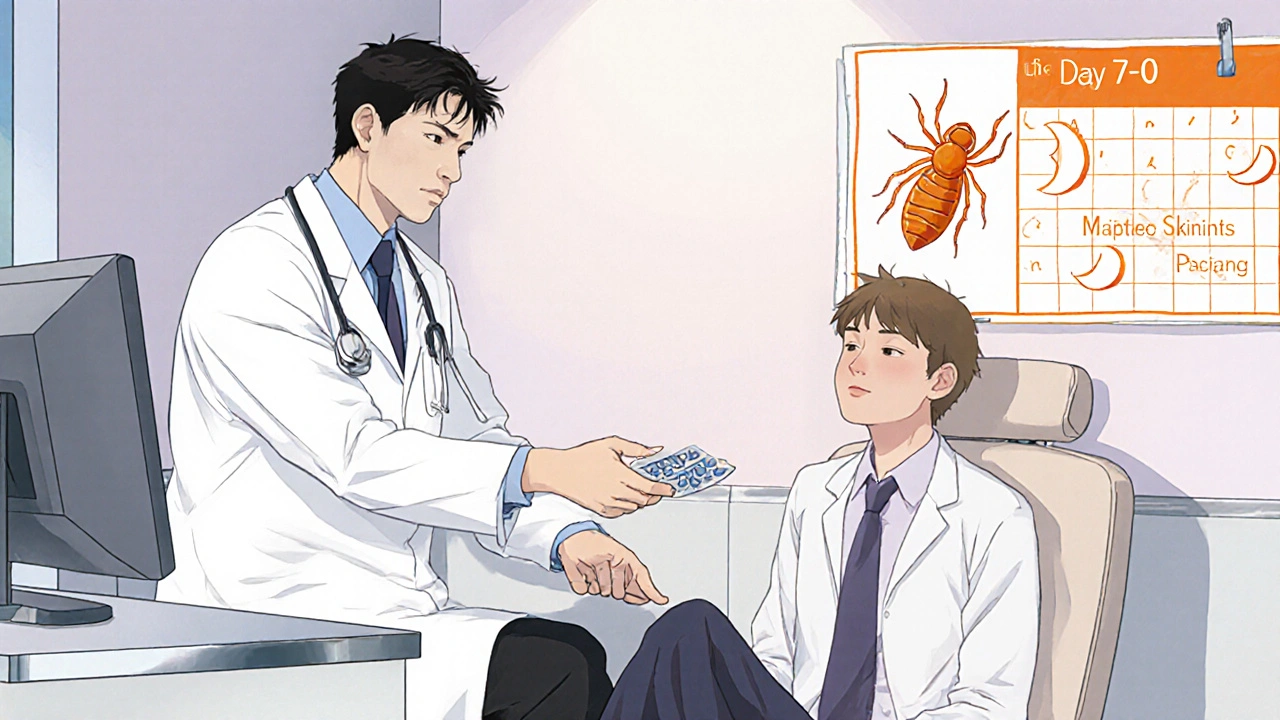When parasites make their home on the skin, the treatment plan can feel like a maze. Ivermectin for skin parasites offers a single, oral solution that works across several nasty bugs, from the itch‑inducing scabies mite to the creeping larvae that drift under your feet. Below you’ll find a practical guide that explains how the drug works, which conditions it can clear, dosing tips, safety warnings, and a quick‑reference table to compare it with the most common topical alternatives.
What is Ivermectin?
Ivermectin is a broad‑spectrum antiparasitic medication that targets glutamate‑gated chloride channels in the nerve and muscle cells of invertebrates, causing paralysis and death of the parasite. First approved for veterinary use in the 1980s, it earned a human‑medicine nod in 1996 for onchocerciasis and quickly expanded to a host of other infections.
How Ivermectin Tackles Skin Parasites
The drug’s ability to cross the skin’s blood supply means that a single oral dose reaches the deeper layers where mites and larvae hide. By disabling the parasites’ nervous systems, it stops them from reproducing and lets the skin heal without the need for repeated topical applications.
Skin Conditions Commonly Linked to Parasites
Not every rash stems from a bacterial or fungal infection-some are the direct result of tiny invaders. The most frequent culprits that respond well to ivermectin include:
- Scabies - an infestation by the mite Sarcoptes scabiei, which burrows into the upper skin layer causing intense itching
- Cutaneous larva migrans - a creeping eruption caused by the hookworm larvae Ancylostoma braziliense that penetrates the skin, usually after walking barefoot on contaminated sand
- Demodex folliculorum - a microscopic mite that lives in hair follicles and can exacerbate rosacea or cause follicular papules when overpopulated
- Myiasis - infestation of living tissue by fly larvae, often seen in travelers with neglected wounds
Dosage Guidelines and Safety Considerations
For adults, the standard oral dose is 200 µg per kilogram of body weight, taken as a single tablet. In many cases, especially for stubborn scabies, a second dose is given after 7-10 days to catch any newly hatched mites.
Key safety points:
- Check liver function before starting therapy; severe hepatic impairment may require dose adjustment.
- Pregnant or breastfeeding women should avoid ivermectin unless the benefit clearly outweighs the risk.
- Common side effects are mild - headache, nausea, or transient dizziness. Severe neurotoxicity is rare but can occur in patients with a genetic deficiency in the P‑glycoprotein transporter.
- Drug interactions are limited, but avoid concurrent use with strong CYP3A4 inhibitors such as ketoconazole.

Condition‑Specific Treatment Protocols
Scabies
Scabies is notorious for spreading quickly in crowded settings. Oral ivermectin offers a convenient alternative to the traditional topical permethrin 5% cream.
- Calculate the dose (200 µg/kg) and give the first tablet on day 0.
- Repeat the same dose on day 7-10 to target newly emerged mites.
- Wash all clothing, bedding, and towels in hot water (≥60 °C) and dry on high heat.
- Treat close contacts simultaneously, even if they are asymptomatic.
In severe crusted scabies, weekly dosing for 4-6 weeks may be required, often combined with topical agents.
Cutaneous Larva Migrans
The serpiginous tracks left by Ancylostoma braziliense larvae usually resolve on their own within weeks, but treatment accelerates healing and reduces itching.
- Single oral dose of 200 µg/kg ivermectin.
- Repeat after 7 days if the lesion continues to migrate.
- Topical 0.1% thiabendazole cream is an alternative for patients who cannot take oral medication.
Demodex Folliculorum Overgrowth
While Demodex mites are normal residents, overgrowth can aggravate rosacea or cause pustular eruptions.
- Two oral doses of 200 µg/kg ivermectin, spaced 7 days apart, are commonly prescribed.
- Adjunctive tea‑tree oil shampoos or topical metronidazole can help control bacterial overgrowth.
Myiasis
Cutaneous myiasis presents as a painful, foul‑smelling wound with visible larvae.
- Oral ivermectin 200 µg/kg daily for 3‑5 days, combined with manual removal of larvae.
- Ensure wound hygiene and cover with sterile dressings to prevent secondary infection.
Comparison Table: Ivermectin vs. Permethrin for Scabies
| Aspect | Ivermectin | Permethrin 5% |
|---|---|---|
| Formulation | Oral tablet | Topical cream |
| Typical dosing | 200 µg/kg on day 0 and day 7-10 | Single application overnight, repeat after 7 days if needed |
| Effectiveness (clinical trials) | ~92% cure rate | ~85% cure rate |
| Compliance challenges | Requires swallowing pills, potential GI upset | Messy application, may cause skin irritation |
| Best for | Mass outbreaks, crusted scabies, patients with limited skin access | Isolated cases, infants, pregnant women (when oral contraindicated) |
Practical Checklist for Clinicians and Patients
- Confirm diagnosis with skin scraping or dermoscopy before prescribing.
- Calculate exact weight‑based dose; round to nearest whole tablet.
- Discuss potential side effects and advise monitoring for dizziness or visual changes.
- Plan a follow‑up visit 2 weeks after the final dose to ensure resolution.
- Educate household members about simultaneous treatment and environmental cleaning.
- Document any contraindications (pregnancy, severe liver disease, known drug interactions).

Common Misconceptions
Myth: “Ivermectin is only for livestock.”
Reality: Human formulations have been approved worldwide for a variety of parasitic diseases and are routinely prescribed by dermatologists.
Myth: “One dose cures everything.”
Reality: For many skin parasites, especially scabies, a repeat dose is essential to hit newly hatched mites.
Myth: “Topicals are always safer.”
Reality: Topical agents can cause allergic dermatitis and are hard to apply evenly on large or crusted lesions; oral ivermectin often offers better systemic coverage.
When to Seek Specialist Care
If symptoms persist after two complete treatment cycles, consider referral to a dermatologist or infectious disease specialist. Persistent itching could signal secondary bacterial infection, immune-mediated dermatitis, or a resistant parasite strain.
Future Directions
Research is expanding ivermectin’s scope beyond traditional parasites. Ongoing trials are evaluating its anti‑inflammatory properties for chronic rosacea and even its antiviral potential against emerging viruses. While these uses remain experimental, they underscore the drug’s versatility.
Can I take ivermectin if I’m pregnant?
Pregnancy is a contraindication unless the benefit clearly outweighs the risk. Most guidelines recommend postponing treatment until after delivery and using topical alternatives when possible.
How fast does ivermectin work on scabies?
Most patients notice reduced itching within 3‑5 days, but complete eradication of mites usually requires the second dose at day 7‑10.
Is a single dose enough for cutaneous larva migrans?
A single 200 µg/kg dose often clears the infection, but if the serpiginous track keeps moving after 5‑7 days, a second dose is advised.
Can ivermectin be used for rosacea caused by Demodex?
Yes, two oral doses spaced a week apart are an evidence‑based option for Demodex‑associated rosacea, often paired with topical metronidazole or azelaic acid.
What should I do if I miss a dose?
Take the missed dose as soon as you remember, then continue with the original schedule. If it’s already close to the next dose, skip the missed one and resume the planned timing.

Sarah Keller
Ivermectin embodies a fascinating convergence of chemistry and humanity’s age‑old battle against invisible invaders.
When we examine the parasite’s lifecycle we glimpse the delicate balance of ecosystems that we constantly disrupt.
Yet the very fact that a single oral pill can dismantle that balance in our favor is a triumph of modern medicine.
The drug’s mechanism-paralyzing the glutamate‑gated chloride channels-mirrors a philosophical lesson: sometimes the weakest link determines the fate of the whole.
In practice, dermatologists must weigh the ethical imperative to relieve suffering against the responsibility to prevent resistance.
This is especially true in crowded communities where scabies can erupt like a social contagion.
By treating the entire household simultaneously we embrace a collective ethic that values solidarity over individual convenience.
Moreover, the dosing regimen-initial dose followed by a repeat after a week-serves as a reminder that true change rarely happens in a single flash.
Patients should be counseled to wash bedding at high temperatures, because neglecting the environment would nullify the pharmacologic effort.
The safety profile, while generally mild, demands vigilance in those with hepatic impairment, reminding us that the body’s complex systems cannot be ignored.
Pregnant women face a dilemma that forces us to confront the limits of our knowledge and the precautionary principle.
From a broader perspective, ivermectin’s emerging research into anti‑inflammatory and antiviral potentials challenges our categorical thinking about drug repurposing.
This fluidity of application illustrates the dynamic nature of scientific discovery, where today’s solution can become tomorrow’s platform.
Therefore, clinicians should stay updated, engage with evolving guidelines, and share insights within their professional networks.
Only through such aggressive yet collaborative stewardship can we ensure that ivermectin remains a potent ally against skin parasites while safeguarding future efficacy.
Veronica Appleton
The standard oral dose is 200 micrograms per kilogram of body weight you give the first tablet on day zero then repeat a week later for stubborn cases also make sure to wash all clothing bedding and towels in hot water at least 60 degrees Celsius to kill any remaining mites and larvae this simple step cuts down reinfestation rates dramatically
the sagar
Don't trust the pharma they want you to stay itchy so you keep buying their pricey creams.
Clinton Papenfus
Accurate weight‑based dosing is essential for ivermectin efficacy and safety. Calculate the dose precisely then administer the tablet as directed. Avoid rounding errors that could compromise treatment outcomes.
Zaria Williams
I think a lot of folks just ignore the simple steps like washing clothes in hot water its kinda basic but they keep gettin re‑infested. If you dont clean the environment the meds wont do much good. Also i feel like people overuse the drug without checking liver function which is just plain reckless.
ram kumar
While the practical tips are sound, the overly simplistic tone betrays a lazy approach to a complex therapeutic protocol. The drama of "just wash your sheets" ignores the nuanced pharmacokinetics and the potential for resistance. A deeper, more critical analysis would serve the community better than this superficial checklist.
Melanie Vargas
Great summary! 🌟 I love how you broke down the dosing schedule and even added the environmental steps. It really helps newcomers feel confident about tackling scabies or larva migrans. Keep spreading the knowledge! 😊
Deborah Galloway
Thanks for the straightforward dosing info. It’s comforting to see a clear plan without a lot of jargon. I feel more at ease about trying ivermectin now.
Charlie Stillwell
Honestly, the misspelled advice in the previous comment shows a lack of professional rigor. When discussing pharmacodynamics and drug‑drug interactions, precision is non‑negotiable. Using emojis and casual language undermines the seriousness of antiparasitic therapy. ⚠️
Ken Dany Poquiz Bocanegra
Exactly, concise guidance helps everyone stay on track and feel hopeful about recovery.
Tamara Schäfer
Ths crtic is exessive i think the orignl tips are vry usefull dont need to belittl them too much
Tamara Tioran-Harrison
Ah, a formal reminder that one must not neglect the meticulous calculation of dosage. How droll it would be if we ignored such elementary principles, would it not? :)
kevin burton
Indeed, precise calculations are critical. Always double‑check the patient’s weight before prescribing.
Max Lilleyman
👍 Got it! Thanks for the reminder.